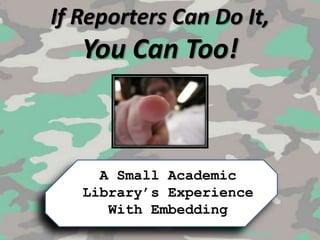If Reporters Can Do It, YOU Can Too!
- 1. If Reporters Can Do It, You Can Too!A Small Academic Library¡¯s Experience With Embedding
- 2. Sarah L. HoodEdensJ.Drake Libraryshood@columbiasc.edu
- 3. 8 Full-Time Staff6 with MLS/MLIS
- 4. 3 of us are ref librarians, but we split and share various other duties between us, such as Electronic Svcs, Instruction, Periodicals, web site
- 6. 1 Administrative AssistantLIBRARY8 Full-Time StaffIT: 9 Full-Time Staff1 Director
- 7. 2 Instructional Technology Consultants
- 11. What is EMBEDDING?2 Types:
- 12. What is ¡¡EMBEDDING? Physical What is ¡¡EMBEDDING? Physical
- 13. Electronic
- 15. GOOD WORKING RELATIONSHIPSL i b r a r i a n sF a c u l t yI T
- 16. ¡±We all have titles but really we allwork togetherandsharetheresponsibilitiesto provide thebest support- Dave Medeiros Director of IT Columbia Collegewe can.¡±
- 17. Never done it before
- 19. I¡¯ve got 18 papers to grade and a Committee meeting to prepare for. Um, I think my support for this is starting to waver.Faculty Member
- 21. DifferentLEVELS
- 22. BASICProvides linksto library resources
- 25. Online Chat
- 26. General Instructional resources BASICLibrary website
- 27. Online Chat
- 30. MID-LEVEL: Basic +Persistent links to some course readings MID-LEVEL: Basic +Persistent links to some course readings
- 31. Helpful / new books MID-LEVEL: Basic +Persistent links to some course readings
- 32. Helpful / new books
- 33. Best databases / database trialsMID-LEVEL: Basic +Persistent links to some course readings
- 34. Helpful / new books
- 35. Best databases / database trials
- 36. Tips from librarians, faculty, studentsMID-LEVEL: Basic +Persistent links to some course readings
- 37. Helpful / new books
- 38. Best databases / database trials
- 39. Tips from librarians, faculty, students
- 40. Course-specific instructional resources FULL SERVICE:MID-LEVELplus
- 41. FULL SERVICE: Mid-Level +Librarian can:
- 42. Participate in online course discussionsFULL SERVICE: Mid-Level +Librarian can:
- 43. Participate in online course discussions
- 44. See/commenton studentbibliographiesFULL SERVICE: Mid-Level +Librarian can:
- 45. Participate in online course discussions
- 47. PossibleassessmentofIL skillsFULL SERVICE: Mid-Level +Librarian can:
- 48. Participate in online course discussions
- 51. Other Privileges as faculty member allowsResearchCoachShow ¡®em what it looks like!LibrarianCOMM 240
- 52. "I found out the hard way that project members did not know¡what proper research consisted of. To have this resource at the beginning of class would have been a huge help. If the students realized what a gold mine of resourcesthe library and coaches provide they may produce a higher standard of work.¡° - Student
- 53. ¡°±õ enjoyed the processand look forward to spending more time in the library.¡° - Student
- 54. ¡°±õ am thrilled with the individualized assistance you have given the students.¡±- Dr. Christine Hait Faculty Member HON 490
- 55. ¡°You were a huge help. They [the students] were truly grateful.¡±- Dr. Helen Tate Faculty Member COMM 240
- 56. I¡¯ve got 18 papers to grade and a Committee meeting to prepare for. Um, I think my support for this is starting to waver.Faculty Member
- 57. CoachSOLVED!
- 58. ?
- 59. Does embeddingREPLACEthe IL Session?
- 60. OUT OF THE OFFICE
- 61. ?
- 62. ReferencesAmerican Library Association. (2011). TEACH Act Best Practices using Blackboard?. In Distance Education and the TEACH Act. Retrieved from http://www.ala.org/Template.cfm?Section=distanceed&Template=/ContentManag ement/ContentDisplay.cfm&ContentID=34705Chesnut, M., Henderson, S. M., Schlipp, J., & Zai III, R. (2009). Value-added library resources & services through Blackboard. Kentucky Libraries, 73(1), 6-12. Columbia College. Press Room: Stock Photos. (n.d.) Retrieved from http://www.columbiacollegesc.edu/news/stock/index.asp Copyright Clearance Center. Using Electronic Reserves: Guidelines and Best Practices for Copyright Compliance. Retrieved from http://www.copyright.com/media/pdfs/Using-Electronic-Reserves.pdfCreative Commons. (n.d.). Retrieved from http://creativecommons.orgGeorge, J., & Martin, K. (2004). Forging the library courseware link. College & Research Libraries News, 65(10), 594-613. Gibbons, S. (2005). Strategies for the Library: CMS Integration Barriers. Library Technology Reports, 41(3), 24-32. Retrieved from http://web.ebscohost.comHerring, S. D., Burkhardt, R. R., & Wolfe, J. L. (2009). Reaching remote students. College & Research Libraries News, 70(11), 630-633. Love, M., & Norwood, S. (2007). Finding Our Way as "Embedded Librarians". College & Undergraduate Libraries, 14(4), 87-93. doi:10.1080/10691310802128369Ramsay, K. M., & Kinnie, J. (2006). THE EMBEDDED LIBRARIAN. Library Journal, 131(6), 34-35. Retrieved from http://web.ebscohost.comYork, A. (2006). The embedded librarian service at MTSU [Supplemental material]. Tennessee Libraries. Retrieved from http://www.tnla.org
Editor's Notes
- #36: Notes: test












































